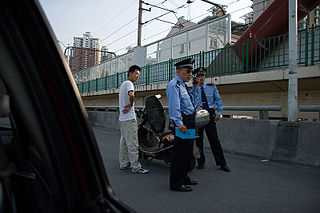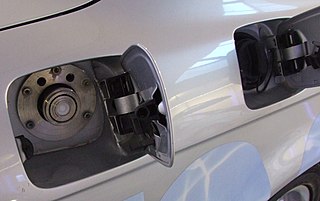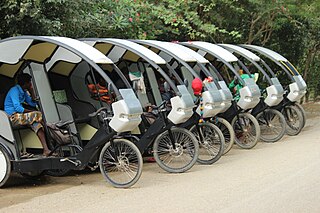Related Research Articles

Transport in India consists of transport by land, water and air. Road transport is the primary mode of transport for most Indian citizens, and India's road transport systems are among the most heavily used in the world.

A hydrogen vehicle is a vehicle that uses hydrogen fuel for motive power. Hydrogen vehicles include road vehicles, rail vehicles and hydrogen-fueled space rockets, as well as hydrogen-powered ships and aircraft. Motive power is generated by converting the chemical energy of hydrogen to mechanical energy, either by reacting hydrogen with oxygen in a fuel cell to power electric motors or, less commonly, by hydrogen internal combustion.

An auto rickshaw is a motorized version of the pulled rickshaw or cycle rickshaw. Most have three wheels and do not tilt. They are known by many terms in various countries including auto, auto rickshaw, baby taxi, mototaxi, pigeon, jonnybee, bajaj, chand gari, lapa, tuk-tuk, tum-tum, Keke-napep, Maruwa, Adaidaita Sahu, 3wheel, pragya, bao-bao, easy bike, CNG and tukxi.

The hydrogen economy is an umbrella term that draws together the roles hydrogen can play alongside renewable electricity to decarbonize those sectors and activities which may be technically difficult to decarbonize through other means, or where cheaper and more energy-efficient clean solutions are not available. In this context, hydrogen economy encompasses hydrogen's production through to end-uses in ways that substantively contribute to avoiding the use of fossil fuels and mitigating greenhouse gas emissions.

A fuel cell vehicle (FCV) or fuel cell electric vehicle (FCEV) is an electric vehicle that uses a fuel cell, sometimes in combination with a small battery or supercapacitor, to power its onboard electric motor. Fuel cells in vehicles generate electricity generally using oxygen from the air and compressed hydrogen. Most fuel cell vehicles are classified as zero-emissions vehicles that emit only water and heat. As compared with internal combustion vehicles, hydrogen vehicles centralize pollutants at the site of the hydrogen production, where hydrogen is typically derived from reformed natural gas. Transporting and storing hydrogen may also create pollutants. Fuel cells have been used in various kinds of vehicles including forklifts, especially in indoor applications where their clean emissions are important to air quality, and in space applications. Fuel cells are being developed and tested in trucks, buses, boats, ships, motorcycles and bicycles, among other kinds of vehicles.
The automotive industry in India is the fourth-largest by production in the world as per 2022 statistics. As of 2023, India is the 3rd largest automobile market in the world in terms of sales. In 2022, India became the fourth largest country in the world by the valuation of its automotive industry.

A fuel gas-powered scooter is a scooter powered by fuel gas. Fuel gases include such fuels such as liquefied petroleum gas (LPG), compressed natural gas (CNG), biogas and hydrogen (HICE). Hydrogen use in two-wheelers has only recently being started to be looked into, mainly by developing countries, to decrease local pollution at an affordable cost.
Hydrogen technologies are technologies that relate to the production and use of hydrogen as a part hydrogen economy. Hydrogen technologies are applicable for many uses.
The energy policy of India is to increase the locally produced energy in India and reduce energy poverty, with more focus on developing alternative sources of energy, particularly nuclear, solar and wind energy. Net energy import dependency was 40.9% in 2021-22.

The Auto Expo is a biennial automotive show held in Greater Noida, NCR, India.

Mahindra Last Mile Mobility Limited, formerly known as Mahindra Electric Mobility Limited (2016-2023) and Reva Electric Car Company (2010-2016), is an Indian company based in Bangalore that designs and manufactures compact electric vehicles. The company's first vehicle was the REVAi electric car, available in 26 countries with 4,000 versions sold worldwide by mid-March 2011. Reva was acquired by Indian conglomerate Mahindra & Mahindra in May 2010. After the acquisition, the company launched the electric hatchback e2o in 2013. Today, the company sells electric vehicles in different segments – the electric sedan eVerito, the electric commercial vehicle eSupro, and the Treo range of low maintenance, lithium-ion battery-powered three-wheelers. Recently, Mahindra Electric became the first Indian car manufacturer to cross 170 million kilometres travelled on its fleet.

A hydrogen internal combustion engine vehicle (HICEV) is a type of hydrogen vehicle using an internal combustion engine. Hydrogen internal combustion engine vehicles are different from hydrogen fuel cell vehicles. Instead, the hydrogen internal combustion engine is simply a modified version of the traditional gasoline-powered internal combustion engine. The absence of carbon means that no CO2 is produced, which eliminates the main greenhouse gas emission of a conventional petroleum engine.

The Mahindra e2o, previously Reva NXR, is an urban electric car hatchback manufactured by Mahindra Reva or Reva Electric Vehicles in 2013–2017. The e2o is the successor of the REVAi and was developed using Reva's technology, and has a range of 120 km (75 mi).

Mahindra Susten Pvt. Ltd., formerly Mahindra EPC Services Pvt. Ltd. , is part of the US$19 billion Mahindra Group. They are a portfolio company under the Cleantech arm of Mahindra Partners.

Electric rickshaws are small 3-wheeled vehicles powered by a battery-powered electric motor ranging from 650 to 1,400 watts. These small electric vehicles have lower fuel costs than auto rickshaws and greater mobility than pulled rickshaws leading their popularity and widening acceptance in some cities since 2008. Electric rickshaws are mostly manufactured in India, Bangladesh, Nepal and China.
The electric vehicle industry in India is slowly growing. The central and state governments have implemented schemes and incentives to promote electric mobility, and have introduced regulations and standards. Although India would benefit from converting its transport from internal combustion (IC) engines to electric motors, challenges include a lack of charging infrastructure, high initial cost and a lack of renewable energy. E-commerce companies, car manufacturers, app-based transport network companies and mobility-solution providers have entered the sector, however, and are slowly building electric-car capacity and visibility.
Chetan Maini is a Co-Founder and Vice Chairman at SUN Mobility and an Indian business magnate in the electric car industry. He is best known for building India's first electric car, REVA, and as the Founder of Reva Electric Car Company Ltd, now Mahindra Electric Mobility Limited, where he served as an advisor. SUN Mobility, a joint venture between Virya Mobility 5.0 and SUN New Energy Systems, aims to be a provider of charging points and services to accelerate mass electric vehicle usage. Chetan is the director of Maini Group and co-founder of Virya Mobility 5.0. He is also an investor and on the board of several clean-tech start-ups.

SUN Mobility is an electric vehicle energy services company founded in 2017 that develops, manufactures and operates battery swapping infrastructure for electric two-wheelers, three-wheelers, and larger commercial vehicles. Battery swapping as a technology helps accelerate the faster adoption of electric vehicles due to the lower upfront purchase price of electric vehicles, and the lower running costs - particularly in the case of commercial applications.
References
- ↑ India Showcases Hydrogen Fuel Auto-Rickshaws
- ↑ IIT-Delhi scientists develop autos that run on hydrogen; cause negligible pollution
- ↑ Mahindra Showcased Hydrogen-Powered 3-Wheeler at World Hydrogen Technologies Convention 2009
- ↑ MNRE: FAQ
- ↑ "H2 stations worldwide". Archived from the original on 21 September 2019. Retrieved 21 September 2019.
- ↑ India working on more H2 stations
- ↑ Shell plans to open 1200 fuel stations in India, some of which may include H2 refilling
- ↑ Hydrogen Vehicles and Refueling Infrastructure in India